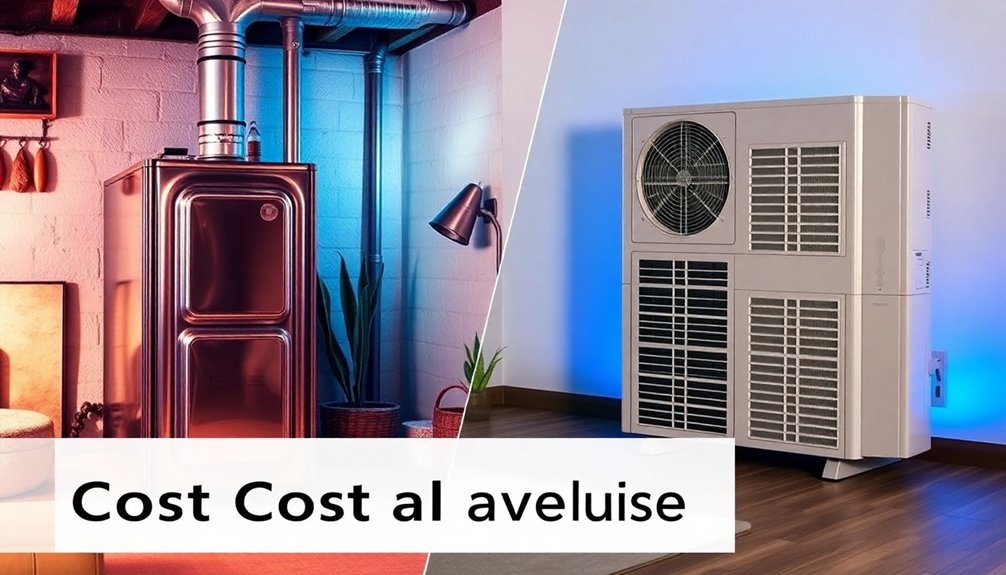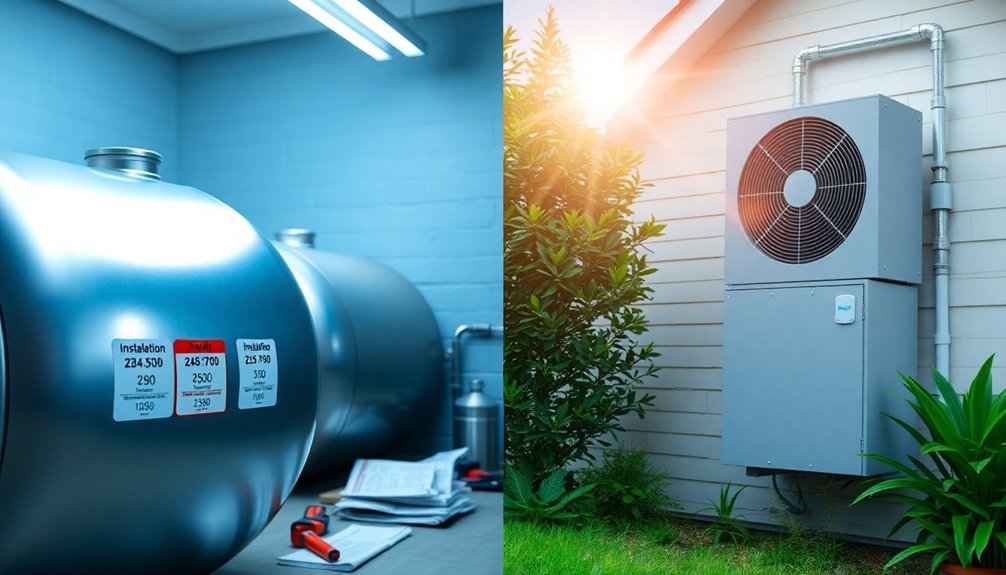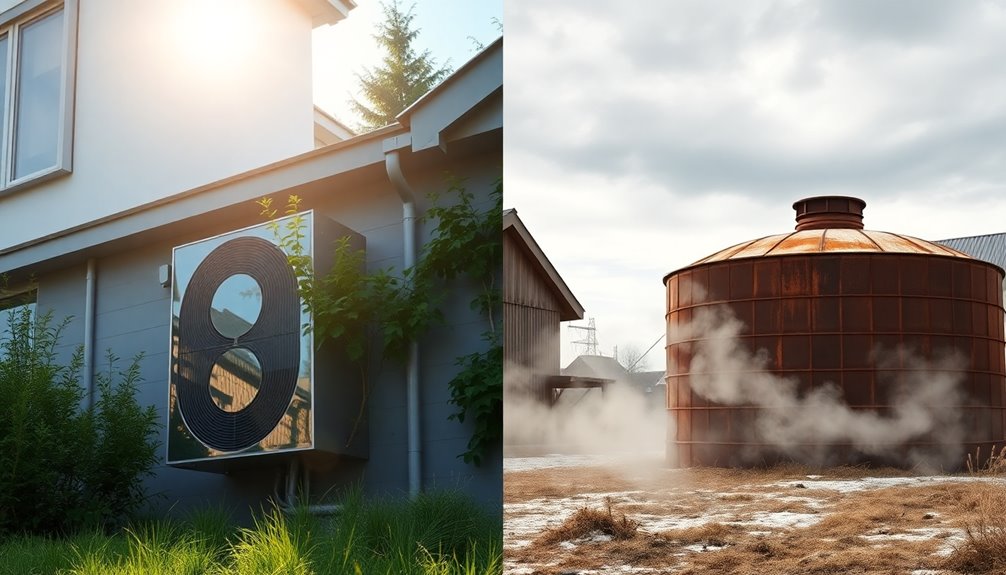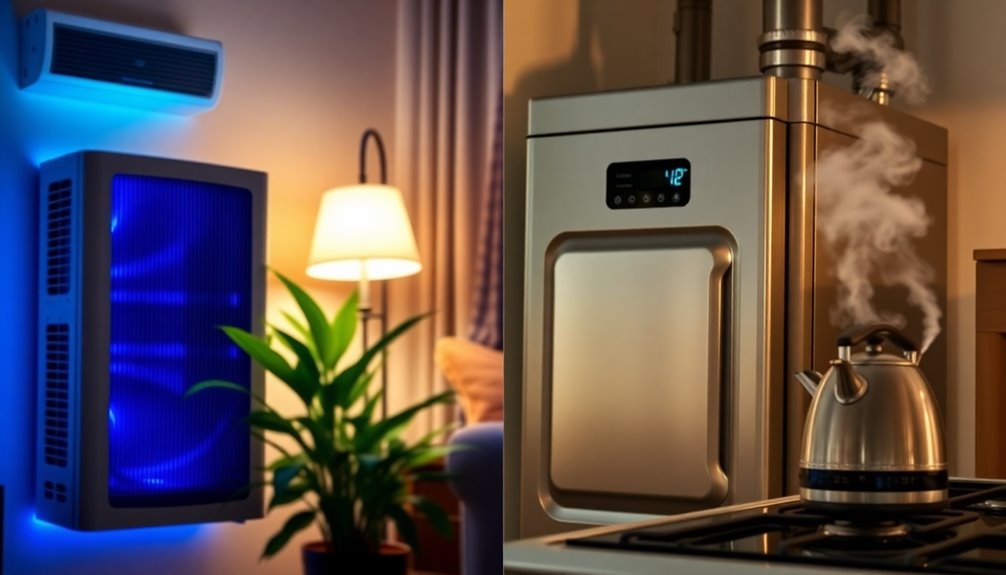Generally, heating with a heat pump is cheaper than oil, especially in the long run. A heat pump costs around $29.31 per million BTUs, while oil heating averages $36.96. Plus, heat pumps can save you about $846 annually compared to oil, particularly if oil prices rise. Although heat pumps have higher installation costs, they often pay off through lower operational and maintenance expenses over time. They also offer a greener option with reduced emissions. If you want to understand more about the costs and benefits of heating options, there's plenty more to explore on this topic.
Overview of Heating Options
When considering your heating options, you'll find two main contenders: heat pumps and oil heating systems. Each has its strengths and weaknesses, making a cost comparison essential for your decision.
Heat pumps stand out with their dual functionality, efficiently heating and cooling your home. They boast a Coefficient of Performance (CoP) that can exceed 4, producing more heat energy than the electrical energy consumed. This energy efficiency can lead to significant long-term savings. Additionally, AI-driven tools can help you find the most cost-effective options for heating solutions. By monitoring savings and investments, homeowners can better understand the financial implications of their heating choices. Moreover, utilizing investment tracking tools can empower homeowners to make informed decisions about their heating expenses.
On the other hand, oil heat is commonly used in the Northeast U.S. While it operates at around 85% efficiency, fluctuating fuel prices—averaging $4.08 per gallon—can impact your overall costs.
Installation costs also vary, with heat pumps ranging from $7,120 to $36,000, while oil furnace installations typically range from $6,400 to $9,200.
When you analyze the total costs, an air source heat pump can produce 1 million BTUs for about $29.31, compared to an oil furnace costing approximately $36.96 for the same amount.
Ultimately, evaluating installation costs, operational expenses, and energy efficiency is vital for making an informed choice between heat pumps and oil heat.
Efficiency of Heating Systems
Evaluating the efficiency of heating systems is key to making an informed choice between heat pumps and oil heating. A heat pump operates with a Coefficient of Performance (COP) that can exceed 4.0, meaning it produces more than four units of heat for every unit of electricity used. This showcases the superior efficiency of heat pumps compared to oil furnaces, which typically achieve about 85% efficiency. Understanding the importance of financial literacy can further enhance decision-making when investing in heating solutions. Additionally, utilizing budgeting apps can help homeowners better manage the costs associated with heating upgrades and energy consumption.
While oil furnaces maintain consistent performance regardless of outdoor temperatures, heat pumps see their efficiency drop considerably in colder weather, falling to about 200% at -15°F.
When you're heating your home, the energy requirements also matter: air source heat pumps need around 293.1 kWh to generate 1 million BTUs, costing approximately $29.31. In contrast, oil furnaces require 7.22 gallons of oil, leading to a cost of $36.96 per million BTUs after accounting for efficiency.
Upgrading to a modern heat pump can lead to substantial annual savings, potentially reaching up to $846 when compared to heating with fuel oil priced at $5 per gallon. Additionally, investing in a heat pump aligns with financial management strategies that emphasize long-term savings and energy efficiency.
Regarding efficiency and long-term savings, heat pumps present a compelling option for homeowners.
Cost Analysis of Oil vs. Heat Pumps

Analyzing the costs associated with heating your home reveals notable differences between oil furnaces and heat pumps. When examining the cost per million BTUs, oil heating averages around $36.96, while heat pumps come in lower at approximately $29.31.
The efficiency of a heating system plays an important role here; oil furnaces operate at about 85% efficiency, whereas heat pumps can achieve a Coefficient of Performance (COP) of 3.0. This means for every unit of energy consumed, heat pumps produce three units of heat, which can lead to considerable savings. Budgeting for financial goals is essential to understanding the long-term implications of heating choices. Additionally, using financial reporting tools can help you visualize the impact of your heating expenses on your overall budget.
For a 2,000-square-foot home, switching from oil to a heat pump could save you around $846 annually, highlighting the long-term financial benefits of heat pumps.
However, installation costs vary considerably. Heat pump systems can range from $7,120 to $36,000, while oil furnace installations are typically between $6,400 and $9,200.
Additionally, operational costs for heat pumps can fluctuate based on regional electricity prices, whereas oil heating costs are more susceptible to the volatility of fuel oil prices. Furthermore, using budgeting apps like investment tracking can help homeowners better manage the costs associated with transitioning to more efficient heating systems.
Environmental Impact Considerations
When you consider the environmental impact of heating options, oil systems generally emit more greenhouse gases than heat pumps. By switching to a heat pump, you not only reduce your carbon footprint but also have the opportunity to use renewable energy sources, further enhancing sustainability. This shift can lead to significant reductions in emissions, making it a smart choice for both your home and the planet. Additionally, investing in sustainable businesses fosters a positive impact on the environment and supports eco-friendly practices. Moreover, opting for sustainable delivery practices when purchasing heating systems can further minimize your overall environmental footprint. Supporting ethical brands that prioritize eco-friendly manufacturing can also play a vital role in promoting a sustainable future.
Greenhouse Gas Emissions
As you evaluate heating options for your home, understanding the greenhouse gas emissions associated with each system is essential.
Oil heating systems release considerable amounts of carbon dioxide (CO2) when burned, contributing to climate change, even with an efficiency of 85%.
In contrast, heat pumps can cut greenhouse gas emissions by up to 7.6 metric tons annually. They achieve this by transferring heat using electricity instead of burning fuel, making them a more environmentally friendly choice.
Here are four key points to evaluate:
- Lower Emissions: Heat pumps greatly reduce greenhouse gas emissions compared to oil heating systems.
- Energy Efficiency: Heat pumps promote better energy efficiency, helping to combat climate change more effectively.
- Renewable Energy Compatibility: When paired with renewable energy sources, heat pumps can further decrease your carbon footprint.
- Long-Term Sustainability: As fossil fuel prices rise, relying on oil heating systems could lead to increased emissions, making heat pumps a sustainable option for the future.
Renewable Energy Integration
Integrating renewable energy sources with heat pumps can dramatically enhance your home's heating efficiency while minimizing environmental impact. By combining a heat pump with solar panels or geothermal systems, you can notably reduce your electricity costs and lower your carbon emissions.
Heat pumps can achieve a Coefficient of Performance (COP) greater than 4 under ideal conditions, meaning they generate more than four units of heat for every unit of electricity consumed. This efficiency makes them far more environmentally friendly than traditional oil heating systems.
Using renewable energy in your heating system can mitigate the greenhouse gas emissions linked to fossil fuels, addressing vital environmental concerns. By shifting to this combination, a typical household could see an estimated reduction of 7.6 metric tons of carbon emissions annually—equivalent to the emissions from driving 18,000 miles.
Moreover, the growing adoption of geothermal heating offers even greater potential for efficiency and sustainability compared to conventional oil systems.
Installation and Maintenance Costs

When considering installation and maintenance costs, you'll find significant differences between heat pumps and oil furnaces.
Heat pumps can carry higher upfront installation costs, especially if you need electrical upgrades, while oil furnaces tend to be less expensive initially. Additionally, incorporating expense management apps can help homeowners better track and budget for ongoing maintenance expenses, ensuring they are prepared for the costs associated with their heating systems. However, understanding ongoing maintenance expenses and potential long-term savings is essential for making the right choice for your home. Additionally, using tools like expense tracking tools can help homeowners budget for these costs effectively. Moreover, using an app with detailed insights and reporting can provide valuable information to help manage these expenses more efficiently.
Installation Cost Comparison
Understanding the costs associated with heating options is essential for homeowners making decisions about their systems. When comparing the installation costs of a heat pump versus an oil furnace, you'll find notable differences that can affect your choice.
- Heat Pump Installation Costs: Typically range from $7,120 to $36,000, averaging around $16,025 after incentives. If you can use existing ductwork, costs may be lower.
- Oil Furnace Installation Costs: Generally lower, these range from $6,400 to $9,200, with an average of about $7,400, making them appealing due to their initial costs.
- Ductless Mini-Splits: If you opt for ductless systems, expect to pay around $4,780 per zone, which could be a cost-effective solution for smaller spaces.
- Additional Electrical Upgrades: Be aware that heat pump installations might require electrical upgrades, potentially increasing your overall installation expense.
While oil furnaces have lower initial costs, heat pumps often deliver long-term savings through greater energy efficiency.
This investment can pay off in the long run, especially when considering annual maintenance needs for both heating systems.
Ongoing Maintenance Expenses
Maintaining your heating system is essential for ensuring efficiency and longevity. When you choose a heat pump, you're committing to annual servicing by an HVAC professional, as well as regular filter changes to keep it running effectively.
Depending on your home's age, you might also need electrical upgrades, adding to your maintenance expenses. On the other hand, oil furnaces also require annual servicing but involve periodic tank refills, which can lead to fluctuating prices based on fuel availability.
While both systems need regular upkeep, heat pumps generally offer better energy efficiency, which can translate into lower operational costs over time.
In contrast, oil furnaces tend to have higher ongoing expenses due to the volatile nature of heating oil prices.
#
Long-Term Savings Potential
Choosing between a heat pump and an oil furnace can considerably impact your long-term savings potential. While oil furnaces often have lower initial installation costs of $6,400 to $9,200, heat pumps, with installation ranging from $7,120 to $36,000, can provide significant savings over time due to their efficiency.
Here's what you should consider:
- Long-Term Savings: Heat pumps can save you about $846 annually compared to oil heating at $5 per gallon, making them a more economical choice in the long run.
- Payback Period: The payback period for heat pump installations is estimated at 2 to 7 years, which can help offset those higher upfront costs.
- Operational Costs: Regular maintenance costs for heat pumps involve annual servicing, while oil furnaces require periodic tank refills, affecting your overall expenses.
- Price Fluctuations: Oil prices tend to fluctuate, leading to unpredictable heating costs, whereas the efficiency of heat pumps offers more stable long-term savings.
## Long-Term Savings Potential
When you weigh the options between oil heating and a heat pump, long-term savings really stand out. Homeowners can save an estimated $846 annually by switching to a heat pump, especially when oil prices hover around $5 per gallon.
Although the initial installation costs for a heat pump may be higher, the payback period ranges from just 2 to 7 years based on those annual savings.
Additionally, heating with a heat pump costs approximately $29.31 per million BTUs, compared to $36.96 for oil, showcasing superior energy efficiency. Over time, these savings can meaningfully impact your budget, particularly in regions where fuel prices are on the rise.
Switching to a heat pump doesn't just benefit your wallet; it also aids the environment. By reducing carbon emissions by 7.6 metric tons annually, equivalent to driving 18,000 miles, you're making a responsible choice.
Future Heating Trends

As advancements in heating technology continue to unfold, you'll find a strong emphasis on energy efficiency and environmental sustainability. The future of heating is steering towards innovative solutions that minimize fuel costs and carbon footprints.
Here are some trends to keep an eye on:
- Heat Pumps: With a high Coefficient of Performance (COP), heat pumps are becoming the preferred option, offering greater energy efficiency compared to traditional oil boilers.
- Smart Home Integration: Modern heating systems now allow for smart home control, enabling you to monitor and optimize energy usage effortlessly.
- Renewable Energy Adoption: Geothermal heating and other renewable sources are gaining traction as sustainable heating alternatives, reducing reliance on fossil fuels.
- Regulatory Changes: Anticipated regulations will push for the development and implementation of sustainable heating technologies, encouraging a shift from oil-based systems to greener solutions.
Conclusion
In the battle between oil and heat pumps, the choice often boils down to your specific situation. While heat pumps might have higher upfront costs, they can save you money in the long run, like planting a seed that grows into a fruitful tree. Considering efficiency, installation, and maintenance, heat pumps often emerge as the smarter, greener choice. As energy trends shift, embracing these options could keep your home warm and your wallet happy for years to come.



